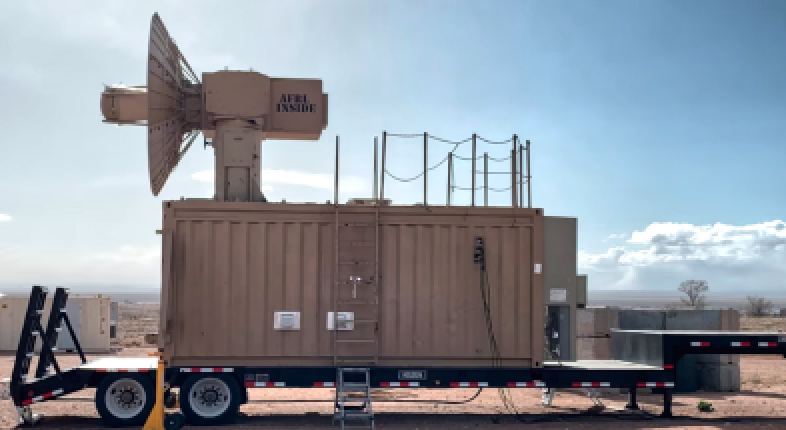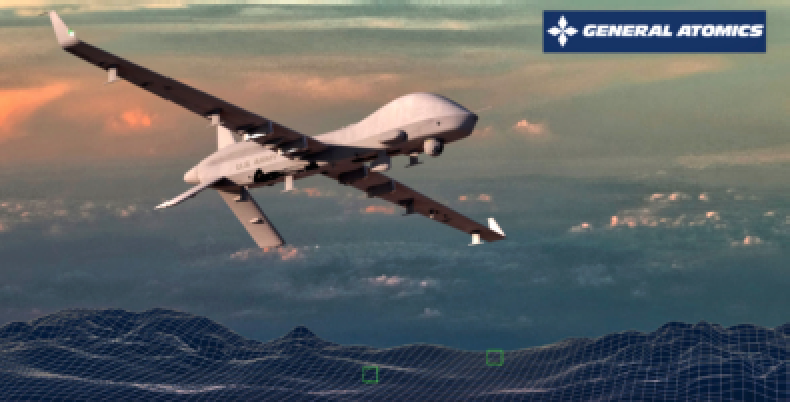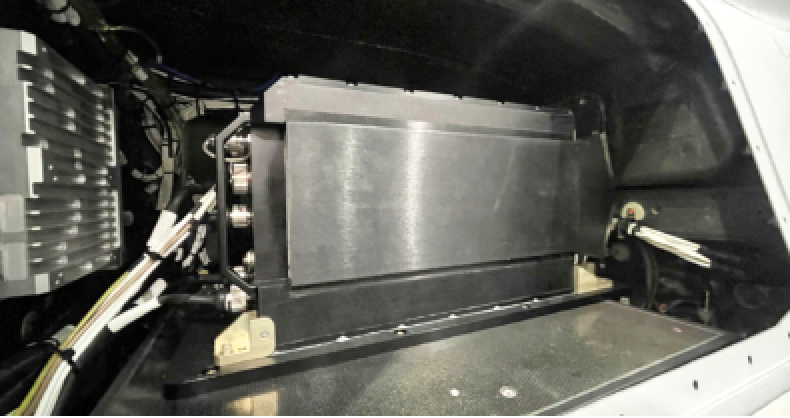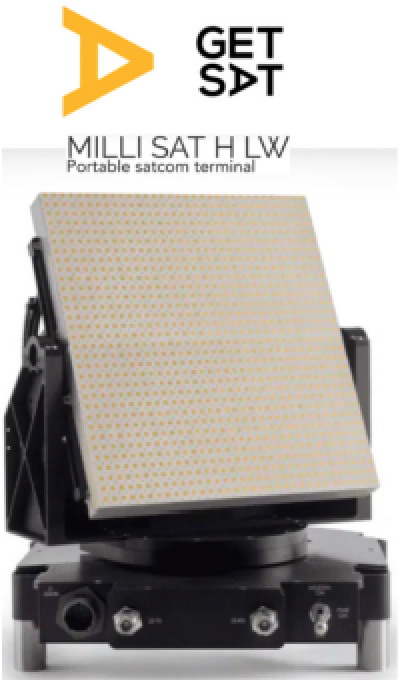AFRL conducts swarm technology demonstration
The Air Force Research Laboratory, or AFRL, conducted a recent demonstration of the organization’s high-power microwave counter drone weapon, the Tactical High- power Operational Responder, or THOR, as it engaged a swarm of multiple targets at Kirtland Air Force Base.
While AFRL celebrates the success of the demonstration, leaders at Kirtland are recognizing the hard work of their team who have decades of research in high-power electromagnetic technologies.

The Tactical High-power Operational Responder,
or THOR, a high-powered microwave counter
drone weapon, stands ready to demonstrate its
effectiveness against a swarm of multiple
targets — the AFRL completed a successful
demonstration of THOR simulating a real-world
swarm attack. This was the first test of this scale
in AFRL history. Photo is courtesy of U.S. Air
Force / Adrian Lucero.
As the dangers from drone swarms evolve, leaders from across the Department of Defense are working closely to ensure we are exploring different technologies like directed energy to support the needs of the warfighter in the future against such threats.
“The THOR team flew numerous drones at the THOR system to simulate a real-world swarm attack. THOR has never been tested against these types of drones before, but this did not stop the system from dropping the targets out of the sky with its non-kinetic, speed-of-light High-Power Microwave, or HPM pulses,” he said.
— Adrian Lucero, THOR program manager at AFRL’s Directed Energy Directorate
“THOR was exceptionally effective at disabling the swarm with its wide beam, high peak powers and fast-moving gimbal to track and disable the targets.”
— Capt. Eric Plummer, a test engineer with AFRL’s Directed Energy Directorate, operated the THOR system and has been with the THOR program for nearly two years — he was responsible for aiming the THOR system at the swarm.
“THOR was extremely efficient with a near continuous firing of the system during the swarm engagement. It is an early demonstrator, and we are confident we can take this same technology and make it more effective to protect our personnel around the world.”
— Capt. Tylar Hanson, THOR deputy program manager
“We couldn’t have come this far without the perseverance and professionalism of the entire THOR team. Our scientists, Airmen and contractors worked early mornings and late nights to make this swarm demo...a great success. AFRL is committed to developing such advanced technologies to defend our service members on the front lines.”
— Ken Miller, AFRL’s high power electromagnetics division chief
About AFRL
The Air Force Research Laboratory is the primary scientific research and development center for the Department of the Air Force. AFRL plays an integral role in leading the discovery, development and integration of affordable warfighting technologies for our air, space and cyberspace force. With a workforce of more than 11,500 across nine technology areas and 40 other operations across the globe, AFRL provides a diverse portfolio of science and technology ranging from fundamental to advanced research and technology development.
BlackSky receive multimillion$$$ contract for advanced tactical imagery services + ground station infrastructure
BlackSky Technology Inc. (NYSE: BKSY) has been awarded a multimillion dollar renewal contract to provide advanced subscription-based tactical imagery and analytics services to an international Ministry of Defense (MoD) customer.
BlackSky’s advanced Spectra AI tasking and analytics platform and high-resolution satellite constellation deliver on-demand, high frequency imagery, monitoring and analytics to customers within 90 minutes.
This unique combination of capabilities enable customers to dynamically monitor areas that matter most to them.
“BlackSky’s commercially available real-time intelligence services are bringing the tactical value of space-based assets into the hands of customers at unprecedented speed and reliability. Real-time space-based imagery and AI- driven analytics contribute the most value when intelligence updates impact live operations. Multiple international ministries of defense have vested confidence in our superior software-to-satellite architecture as they continue to incorporate BlackSky’s imagery and AI-driven analytics into critical day-to-day operations.”
— Brian E. O’Toole, CEO, BlackSky
Additionally, BlackSky has also been awarded a two-year, multimillion dollar, ground station infrastructure augmentation contract that establishes the strategic framework for the company’s next, major, international, advanced tactical ISR Ministry of Defense (MoD) customer.
BlackSky’s international customer base is experiencing a new age of actionable intelligence for international governments, commercial customers, and non-governmental organizations.
Developing ground station capabilities will enable direct access to the company’s proprietary high-resolution, rapid-revisit constellation through the BlackSky Spectra AI tasking and analytics platform.
DARPA contracts BAE Systems to develop autonomous space-based surveillance tech
The Defense Advanced Research Projects Agency (DARPA) has awarded BAE Systems’ FAST Labs™ research and development organization a $7 million contract for the Oversight autonomous, space-based, target custody program.

Traditional space intelligence, surveillance, and reconnaissance (ISR) collection can be siloed, labor intensive and unable to dynamically re-evaluate quickly enough to take advantage of new space systems. To address this, DARPA, the U.S. Space Force and the Space Development Agency are developing satellite constellations to improve the tactical relevance of U.S. space systems.
Proliferated LEO satellite constellations are significantly expanding on-orbit, ISR capabilities. The DARPA Oversight program will focus on creating an autonomous system that maintains constant “custody” of a large number of assets across new, diversified constellations. Under the terms of the program, the technology will be deployed to both tactical-edge satellites and ground stations.
Work on the program, which is part of BAE Systems’ autonomous technologies portfolio, includes collaboration with subcontractors OmniTeq and AIMdyn, Inc.
“Rapidly advancing near-peer adversary capabilities are driving a need for additional long-range tracking at increased scale and timeliness. To meet this requirement, our team includes technical expertise in autonomy, space processing, ISR systems, tactical-edge software development, system integration and architectures, and mission focus.”
— Dr. John Grimes, director of Small Satellites at BAE Systems’
About DARPA’s Oversight
DARPA aims to help military planners keep track of up to 1,000 targets of interest through management of available space domain resources. The goal of the Oversight program is to enable constant custody to maintain tracking of targets of interest for tactical missions.
“Oversight seeks to support both peacetime and wartime simultaneous monitoring of high value entities in contested environments, where resources and targets of interest are highly dynamic. Through this program, DARPA aims to extend the applicability of U.S. space assets and make the space domain more tactically relevant for warfighters. We are working with the military service branches on early transitions during Phase 1. We want to get initial products out as fast as possible and that will help cultivate the development needs in Oversight Phase 2, during which we plan to have applications running on hardware resources. Meeting Oversight’s goals will enable military personnel to track important targets of interest at a large scale with fewer operators than is possible today.”
— Lael Rudd, program manager for Oversight in DARPA’s
Tactical Technology Office
U.S. Space Force has been involved since the origin of the program and the Oversight team is in discussions with the Space Development Agency about potential integration into the Proliferated Warfighter Space
Architecture. The U.S. Department of Defense’s Joint All-Domain Command and Control (JADC2) might one day use Oversight’s space- based object tracking capability, providing enhanced situational awareness to assist in faster decision making and expediting government efforts to use the space domain during missions.

“JADC2 is a warfighting necessity to keep pace with the volume and complexity of data in modern warfare and to defeat adversaries decisively. JADC2 enables the Joint Force to “sense,” “make sense,” and “act” on information across the battle- space quickly using automation, artificial intelligence (AI), predictive analytics, and machine learning to deliver informed solutions via a resilient and robust network environment.”
— Department of Defense
The program will leverage a large body of research about efficiently optimizing resources and apply it to use of future and current satellite assets. Oversight plans to also enable collaboration between satellite and ground-based resources. Newly developed algorithms will attempt to detect changing behaviors and dynamically re-task appropriate satellite sensors to track objects at scale.
Phase 1 of the program will define tracking requirements, resource management needs, and interface between technologies in development. In parallel, DARPA will assess current government-owned applications and services that could be leveraged.
This phase will span 15 months, with a possible option of three months inc ontinued development if needed.
GA-ASI SeaGuardian supports Northern Edge 2023
As part of a U.S. Navy contract, an MQ-9B SeaGuardian® Unmanned Aircraft System from General Atomics Aeronautical Systems, Inc. (GA-ASI) supported the NORTHERN EDGE 2023 (NE23) exercise, May 8-19, 2023.

The training exercise, which took place in the Gulf of Alaska, was one of a series of U.S. Indo-Pacific Command (IPACOM) exercises that prepares joint forces to respond to crises in the Asia Pacific region.
GA-ASI’s SeaGuardian is a maritime derivative of the MQ-9B SkyGuardian® and remains the first UAS that offers multi- domain Intelligence, Surveillance, Reconnaissance and Targeting (ISR&T) and has an internal payload suite that can prosecute surface and subsurface targets in support of Fleet Operations.
During NE23, SeaGuardian provided real-time Maritime ISR&T data feeds to the various IPACOM operations centers including Pacific Fleet, Pacific Air Forces, Joint Base Elmendorf- Richardson Joint Exercise Control Group (JECG) and various exercise and real-world watch floors.
Real-time sensor data — including Signals Intelligence (SIGINT), radar, and Full-Motion Video (FMV) — was Processed, Exploited and Disseminated (PED) by operators via Minotaur Mission System.
The Minotaur system was developed by the Johns Hopkins University Applied Physics Laboratory and links sensors, SIGINT, cameras, radar and communications equipment into a single, automated system that allows operators to more efficiently identify, track and target simultaneously with other users for expedited dynamic tasking.
This classified data was transmitted to the Joint Fires Network using new DoD technologies that allow for the smart routing of communications between widely distributed communications nodes.
In addition, SeaGuardian showcased an array of operational payloads, that included Electronic Support Measures (ESM), Radar Moving Target Indication (MTI) and Inverse Synthetic-Aperture Radar (ISAR), Communication Intelligence (COMINT), Automatic Identification System (AIS), high-definition Electro- Optical/Infra-Red (EO/IR) imaging system and Link 16.
The ESM payload on SeaGuardian was supplied by Sierra Nevada Corporation and the COMINT payload was made by L3Harris Technologies. The aircraft featured the SeaVue Multi-role radar from Raytheon Technologies.
GA-ASI’s Link 16 solution leveraged the L3Harris Small Tactical Terminal (STT) KOR-24A radio and Ultra Electronics Air Defense Systems Integrator (ADSI) host software ran on the Parry Labs Stellar Relay Common Compute Module.
The GA-ASI-developed Detect and Avoid (DAA) system was also installed in SeaGuardian and received a limited certification from NAVAIR. This enabled SeaGuardian to perform Beyond Visual Line-Of-Sight (BVLOS) operations within the exercise airspace.
SeaGuardian’s multi-domain capabilities allows it to flex from mission to mission and pass real- time sensor data directly to the fleet through Link 16 and satellite feeds to the shore-based command and intelligence centers.
During NE23, the MQ-9B effectively passed ISR&T information to various surface and air units, and a litany of other U.S. and foreign units taking part in the exercise.
In addition to its contributions to the exercise, the SeaGuardian self- deployed from GA-ASI’s Desert Horizon flight operations facility in El Mirage, California, to Joint Base Elmendorf-Richardson, Alaska, covering more than 2,000 nautical miles in a single flight and demo’d SeaGuardian’s expeditionary attributes.
The aircraft self-deployed back to El Mirage following the exercise. All flights were flown from a forward deployed Mission Command Element comprised of a Certified Ground Control Station and Mission Intelligence Station located Naval Air Station Whidbey Island, Washington, exercising UAS Expeditionary Concept of Operations (CONOPS) in support of Exercise objectives.
Upgraded General Atomics Gray Eagle extended range UAS featured in demo
General Atomics Aeronautical Systems, Inc. (GA-ASI) is supporting a demo that began in March and features two, U.S. Army-owned, Gray Eagle Extended Range (GE-ER) Unmanned Aircraft Systems (UAS).

GA-ASI — the developer of the GE-ER platform — was contracted by the Army to integrate and operate an array of new capabilities on the UAS platform as part of an ongoing effort to modernize GE-ER for Multi-Domain Operations (MDO).
This demonstration employed improved capabilities, including long-range sensors — such as those traditionally flown on manned platforms — and navigation capabilities, as well as rapid integration of advanced sensors and payloads tailorable to specific missions.
GA-ASI’s Multi-Mode Radar photo is courtesy of the company.

As part of this MDO configuration, the next- generation Synthetic Aperture Radar (SAR) used for the demonstration is the new Eagle-Eye Multi-Mode Radar (MMR) supplied by GA-ASI. The Eagle-Eye radar is an MMR that provides increased performance and couples well with other payloads.
Many of the MDO capabilities showcased in this demo are featured in the latest Gray Eagle model, the Gray Eagle 25M, which is designed to meet the range and accuracy to Detect, Identify, Locate & Report (DILR) stationary and moving targets.
The Gray Eagle 25M’s Open Architecture allows easy implementation of Future Airborne Capability Environment (FACE) standards across control interfaces, avionics, datalinks, and provides the ability to integrate a customizable suite of multi-INT sensors providing the Stand-Off Survivability with Stand-In Capability required for Multi-Domain Operations.
“Eagle-Eye easily detects threats and provides precise location data, which eliminates unknowns for the ground tactical commander on today’s dynamic battlefields. Eagle-Eye and the rest of our MDO upgrades can provide reliable performance, ease of operation and true overmatch capability for the U.S. Army.”
— David R. Alexander, GA-ASI President
Get SAT + Inmarsat intro a new small terminal for government aviation
Get SAT and Inmarsat have announced that Inmarsat has type-approved Get SAT’s Milli SAT H LW GX for use on the Global Xpress (GX) network.

Milli SAT H LW GX is a lightweight and compact, all-in-one, on-the-move aero terminal serving the Inmarsat GX network, the world’s first and only globally available, high-throughput, commercial wideband network.
Leveraging Get SAT’s highly efficient, patented InterFLAT miniaturized, flat-panel, antenna technologies, the Milli SAT H LW GX is fully integrated with electronics and software to ensure reliable operations worldwide. The terminal enables a wide range of communications capabilities for military aircraft and uncrewed aerial vehicles (UAVs).

Size and weight limitations have traditionally created challenging requirements for aviation SATCOM applications. The low size, weight and power (SWaP) of the Milli SAT H LW GX makes the terminal well-suited for use in the government aviation market.
Milli SAT H LW GX’s 25×27 cm flat panel antenna fits inside a 40 cm radome, allowing for easy installation. With reduced SWaP, the unit is a new addition to small, Inmarsat type-approved SATCOM user terminals used with GX. The terminal also allows automatic beam switching (ABS) using industry standard OpenAMIP and OpenBMIP protocols, ensuring seamless operations.
“Get SAT is pushing the innovation envelope in creating – and constantly delivering – the industry’s most miniaturized terminals for airborne on-the-move applications. Our mission to craft micronized technologies that support a small flat panel antenna terminal enables our team to consistently find new ways to successfully reduce terminal size while maintaining strength and mission flexibility. We developed our Milli SAT H LW GX terminal to meet Inmarsat’s standards and provide customers with ease of use.”
— Kfir Benjamin, Get SAT CEO
“Designed for worldwide mobility, Global Xpress has worked for commercial and government customers because of its unique worldwide reliability, ease of use, and seamless interoperability with military satellite resources. With the Inmarsat type approval of Get SAT’s airborne terminal, government on-the-move users have access to a very compact terminal to support their critical connectivity requirements worldwide.”
— Matt Wissler, Chief Technology Officer, Inmarsat Government



